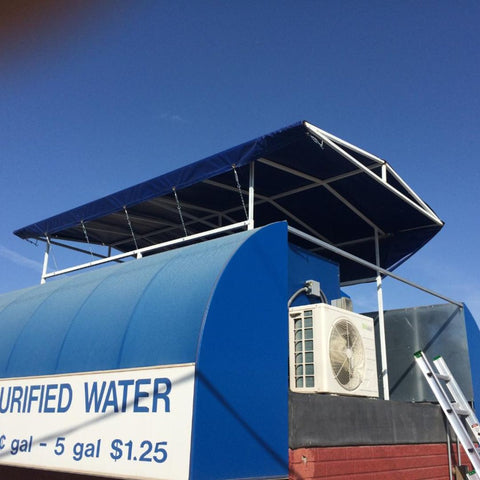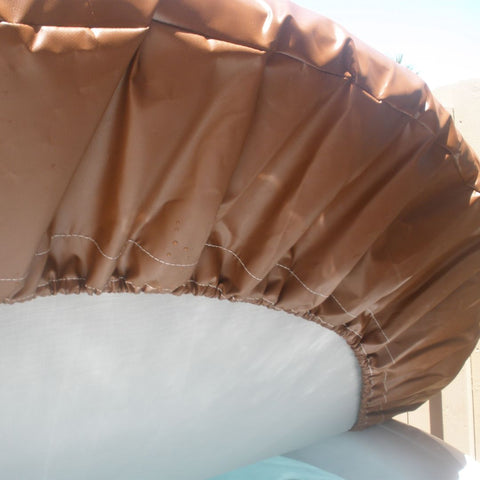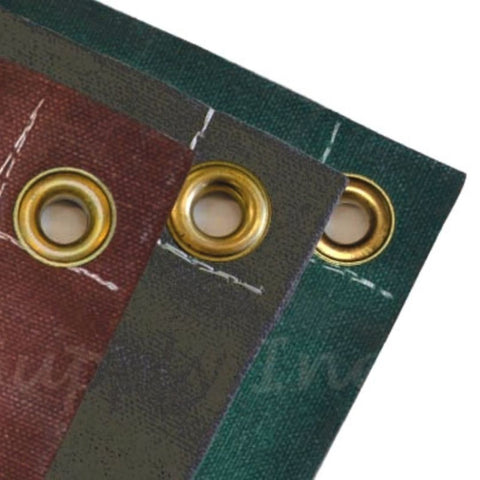To ensure cost-effective protection for your materials, supplies, vehicles, buildings, or areas, opting for Custom Tarps and Covers is the best solution. Whether you're safeguarding construction materials, covering vehicles, or securing cargo, the right tarp can make all the difference. However, with so many options available, selecting the ideal custom tarp requires careful consideration. In this guide, we'll explore the top considerations to ensure you make an informed decision tailored to your needs.
Determine The Purpose
First, identify what you need the tarp for. This will help in deciding the type of material, thickness, and durability required. Tarps can be used for a wide range of purposes including but not limited to covering vehicles, as a roof for temporary shelters, for agricultural purposes, etc.
Proper Material and Durability

The material of your tarp is paramount to its effectiveness and longevity. Tarps are commonly made from polyethylene (poly tarps), vinyl, canvas, and mesh. Each material has distinct advantages and is suited for specific applications. Polyethylene tarps are lightweight, waterproof, and cost-effective, making them ideal for general use. Vinyl tarps offer superior durability and resistance to abrasion, UV light, and chemicals, perfect for heavy-duty applications. Canvas tarps are breathable and eco-friendly, suitable for protecting sensitive materials. Mesh tarps allow for air circulation and are excellent for shade or reducing wind impact without creating a sail effect.
Consider the conditions your tarp will face, including exposure to sunlight, chemicals, and the likelihood of physical wear and tear. Durability also depends on the tarp's thickness and weave density, typically measured in mils (thousandths of an inch) and denier, respectively. A higher number indicates a thicker and more durable tarp.
Correct Size and Shape

Custom tarps can be tailored to fit any size or shape requirement. It's crucial to accurately measure the area or items you intend to cover, allowing for a sufficient overhang or extra material to secure the tarp. Remember, it's better to have a little extra material than to come up short. When specifying your dimensions, consider whether you'll need additional features like grommets or reinforced corners, which can affect the overall size and fit.
Area of Coverage
Determining the dimensions of a space involves measuring its length, width, and height. These measurements are crucial for various purposes, such as furniture fitting, renovation planning, or calculating the area and volume of the space. Here's a step-by-step guide to accurately measure the dimensions of a space:
1. Gather Your Tools
Tape Measure: A long, flexible ruler. A 25-foot tape measure is commonly used for room measurements.
Notepad and Pen: To jot down measurements.
Laser Measure (optional): For quick and precise measurements, especially in larger spaces.
Ladder or Step Stool (if necessary): To reach high points for measuring height.
2. Measure the Length
Start at one corner of the room and extend your tape measure to the opposite corner.
Hold the tape measure straight and level to ensure accuracy. If using a laser measure, aim it directly at the wall you're measuring towards.
Record the measurement on your notepad. Measure in feet and inches for precision.
3. Measure the Width
Choose the adjacent wall to the one you measured for length.
Repeat the process: Extend the tape measure from one corner to the other, keeping it level.
Record the width next to your length measurement.
4. Measure the Height
Choose a corner where two walls meet.
Place the tape measure at the floor level and extend it upwards to the ceiling.
For tall spaces, you may need a ladder or step stool to reach the ceiling.
Record the height measurement on your notepad.
5. Calculate Area
Area: Multiply the length by the width. This gives you the area in square feet (or square meters, depending on your unit of measurement).
6. Double-Check Your Measurements
Measure each dimension at least twice to ensure accuracy.
Check different parts of the room, as some rooms may not be perfectly square or rectangular.
7. Record and Label Measurements
Clearly label each measurement (e.g., "Length: 20 feet," "Width: 15 feet," "Height: 8 feet").
Note any irregularities in the room, such as alcoves or protrusions, which might affect how you use the space.
8. Tips for Accuracy
Measure at floor level for length and width: Floors are generally more level than ceilings.
Use a helper for long distances: They can hold the tape measure in place while you extend it.
Round to the nearest inch if not using a laser measure, to ensure consistency.
Choose Reinforcements and Add-ons

Consider if you need any reinforcements like grommets (metal rings for tying down the tarp), reinforced corners, or hemmed edges. You may also opt for additional features like UV protection, fire resistance, or anti-mildew treatment depending on your application.
Do you need a Waterproof or Water-Resistant?
While it may seem like a minor distinction, the difference between waterproof and water-resistant tarps is significant. Waterproof tarps provide complete protection against water penetration, essential for applications where moisture must be kept at bay. Water-resistant tarps can repel water to a degree but may eventually allow penetration during prolonged exposure or heavy rainfall. Choose based on the level of protection you need against moisture.
UV Protection
Continuous exposure to the sun's ultraviolet (UV) rays can degrade many materials over time. If your tarp will be used outdoors for extended periods, look for options treated with UV inhibitors. These tarps are designed to resist the harmful effects of sunlight, prolonging their life and maintaining their structural integrity. This feature is particularly important for tarps in sunny climates or high-altitude environments.
Ideal Color and Aesthetics
While functionality should be your primary concern, the color and appearance of your tarp might also be important, especially in residential or customer-facing applications. Tarps come in a variety of colors, each with its own set of advantages. For instance, lighter colors reflect sunlight and are cooler underneath, while darker tarps absorb heat and can help snow melt faster in winter applications. Consider the aesthetic and functional impacts of color when making your choice.
Ease of Handling and Storage
The weight and flexibility of your tarp will affect how easy it is to handle, deploy, and store. Heavy-duty tarps offer excellent protection but can be cumbersome to move and set up without assistance. Lightweight tarps are easier to manage but might not provide the same level of durability and protection. Think about your capacity to handle the tarp, especially if quick deployment or frequent moves are anticipated.
Safe & Secure Custom Features

Customization doesn't stop at size and material. Additional features like grommets, D-rings, reinforced edges, and custom straps can enhance the functionality and ease of use of your tarp. Grommets allow for secure tie-downs, preventing the tarp from billowing in the wind. Reinforced edges increase durability where tarps are most likely to wear. Specify your requirements based on how you plan to use and secure the tarp.
Reasonable Price and Value
While cost is always a consideration, the cheapest option may not always offer the best value in the long run. Evaluate the price against the tarp's durability, material quality, and the protection it provides. Investing in a higher-quality, more durable tarp may be more cost-effective over time, reducing the need for replacements and offering better protection for your assets.
Excellent Customer Support
Good customer support can also be invaluable, offering advice on the best options for your needs and assistance in the event of any issues.
Additional Tips in Ordering Custom Tarps & Covers
Find a Reputable Supplier
Research suppliers who specialize in custom tarps. Look for reviews, ask for referrals, or check for industry certifications to ensure you’re dealing with a reputable company.
Request a Quote
Contact the supplier(s) to request a quote. Provide all the specifications you’ve determined. It might be helpful to discuss your needs with a representative who can offer advice or suggest alternatives.
Place Your Order
Once you’re satisfied with the quote and the supplier's credentials, place your order. Be sure to confirm all the details, including the expected delivery date.
Prepare for Delivery
Make sure you're ready to receive the tarp, particularly if it's large or heavy. Consider how you'll unload and store it upon arrival.
Inspect the Tarp Upon Arrival
When your tarp arrives, inspect it thoroughly to ensure it matches your order and is free from defects. If there are any issues, contact the supplier immediately to resolve them.
Conclusion
Choosing the right custom tarp involves balancing a range of factors, including material, size, protective features, and additional custom options. By carefully considering each of these aspects, you can select a tarp that offers the best protection for your needs, ensuring your assets remain secure in any condition. Remember, a well-informed purchase is an investment in peace of mind and long-term value.
When it comes to protecting your valuable assets from the elements, the quality and customization of your tarp can make all the difference. At Tarp Supply Inc.®, we understand that each project has its unique requirements, which is why we specialize in offering a wide range of custom tarps designed to meet your specific needs. Whether you're in need of heavy-duty, weather-resistant tarps for industrial applications, or lightweight, flexible solutions for personal use, we've got you covered.
Don't compromise on quality or fit when it comes to safeguarding your equipment, vehicles, or any valuable outdoor items. Our team of experts is ready to guide you through the top considerations in purchasing custom tarps, ensuring that you get the perfect solution tailored to your situation.
Visit our website at https://www.tarpsupply.com/ to explore our extensive selection and learn more about how we can customize our products to your specifications. If you have any questions or would like to discuss your custom tarp needs, please don't hesitate to give us a call at 630-953-4700. At Tarp Supply Inc.®, we're committed to providing you with high-quality products and exceptional service. Let us help you protect what matters most.





